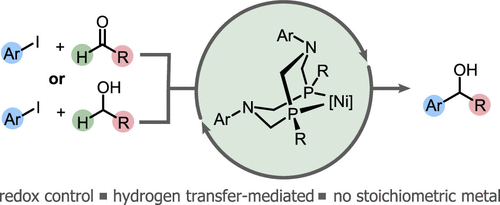当前位置:
X-MOL 学术
›
J. Am. Chem. Soc.
›
论文详情
Our official English website, www.x-mol.net, welcomes your feedback! (Note: you will need to create a separate account there.)
Catalytic Aldehyde and Alcohol Arylation Reactions Facilitated by a 1,5-Diaza-3,7-diphosphacyclooctane Ligand
Journal of the American Chemical Society ( IF 15.0 ) Pub Date : 2021-09-03 , DOI: 10.1021/jacs.1c05661 Eric S Isbrandt 1 , Amrah Nasim 1 , Karen Zhao 1 , Stephen G Newman 1
Journal of the American Chemical Society ( IF 15.0 ) Pub Date : 2021-09-03 , DOI: 10.1021/jacs.1c05661 Eric S Isbrandt 1 , Amrah Nasim 1 , Karen Zhao 1 , Stephen G Newman 1
Affiliation

|
We report a catalytic method to access secondary alcohols by the coupling of aryl iodides. Either aldehydes or alcohols can be used as reaction partners, making the transformation reductive or redox-neutral, respectively. The reaction is mediated by a Ni catalyst and a 1,5-diaza-3,7-diphosphacyclooctane. This P2N2 ligand, which has previously been unrecognized in cross-coupling and related reactions, was found to avoid deleterious aryl halide reduction pathways that dominate with more traditional phosphines and NHCs. An interrupted carbonyl-Heck type mechanism is proposed to be operative, with a key 1,2-insertion step forging the new C–C bond and forming a nickel alkoxide that may be turned over by an alcohol reductant. The same catalyst was also found to enable synthesis of ketone products from either aldehydes or alcohols, demonstrating control over the oxidation state of both the starting materials and products.
中文翻译:

1,5-二氮杂-3,7-二磷酸环辛烷配体促进的催化醛和醇芳基化反应
我们报告了一种通过芳基碘化物偶联获得仲醇的催化方法。醛或醇都可以用作反应伙伴,分别使转化还原或氧化还原中性。该反应由 Ni 催化剂和 1,5-二氮杂-3,7-二磷酸环辛烷介导。这个 P 2 N 2以前在交叉偶联和相关反应中未被识别的配体被发现可以避免有害的芳基卤化物还原途径,而这些途径主要由更传统的膦和 NHCs 支配。提出了一种间断的羰基-Heck 型机制,其中一个关键的 1,2-插入步骤形成新的 C-C 键并形成可能被醇还原剂翻转的镍醇盐。还发现相同的催化剂能够从醛或醇合成酮产物,证明对起始材料和产物的氧化态的控制。
更新日期:2021-09-15
中文翻译:

1,5-二氮杂-3,7-二磷酸环辛烷配体促进的催化醛和醇芳基化反应
我们报告了一种通过芳基碘化物偶联获得仲醇的催化方法。醛或醇都可以用作反应伙伴,分别使转化还原或氧化还原中性。该反应由 Ni 催化剂和 1,5-二氮杂-3,7-二磷酸环辛烷介导。这个 P 2 N 2以前在交叉偶联和相关反应中未被识别的配体被发现可以避免有害的芳基卤化物还原途径,而这些途径主要由更传统的膦和 NHCs 支配。提出了一种间断的羰基-Heck 型机制,其中一个关键的 1,2-插入步骤形成新的 C-C 键并形成可能被醇还原剂翻转的镍醇盐。还发现相同的催化剂能够从醛或醇合成酮产物,证明对起始材料和产物的氧化态的控制。



























 京公网安备 11010802027423号
京公网安备 11010802027423号